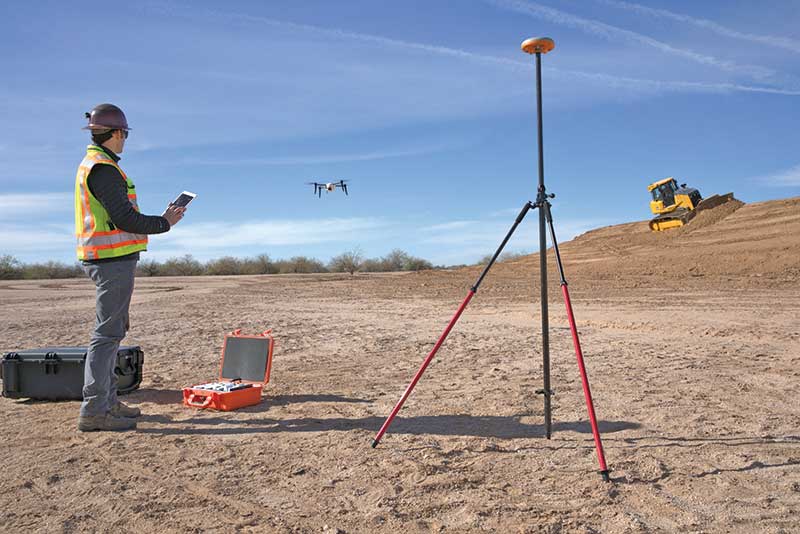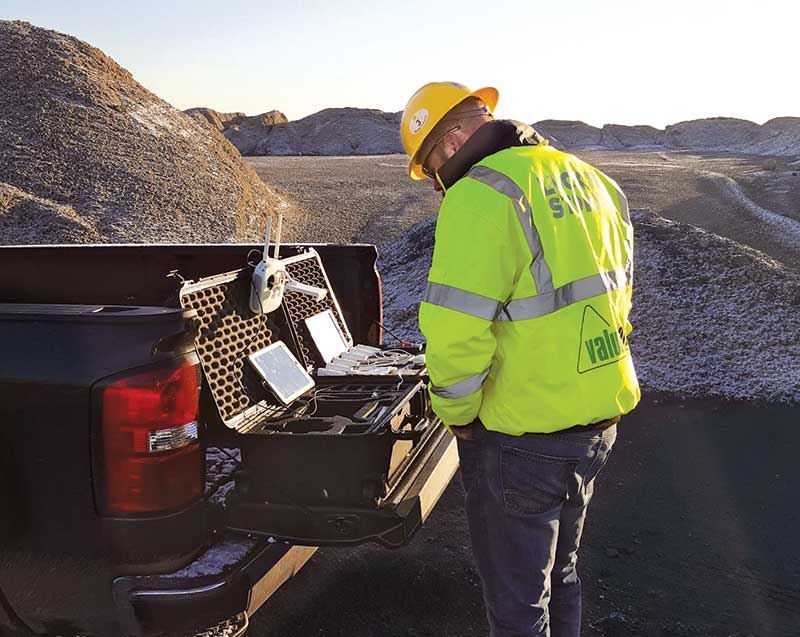7 takeaways for aggregate producers from InterDrone 2017

Attendance at InterDrone 2017 was up over the previous year, a show organizer says. Photo by Kevin Yanik
About 4,000 attendees and 65 exhibiting companies participated in InterDrone 2017, a three-day UAV conference and expo held in September in Las Vegas.
The show was a first for Pit & Quarry, which has kept close tabs on the drone evolution throughout 2017. InterDrone brought a number of representatives from aggregate-producing companies to Las Vegas to explore the viability of drone technologies for their businesses. These producers sought to familiarize themselves with the vendors in this space and learn the latest on the drones research-and-development front.
At Interdrone, an educational track focused on mining and aggregate provided our industry’s producers with opportunities to hear from experts in the UAV industry. These experts shared best practices for flying drones, collecting data, staying in compliance with Federal Aviation Administration regulations, and more.
Pit & Quarry departed InterDrone with a number of things to chew on. Here are seven for aggregate producers to consider:
1. There are a slew of potential vendor partners to choose from.
If you’re an aggregate producer who has yet to explore the use of a drone for your operation and you attended InterDrone for the first time, you certainly went to the right place.
At the same time, sifting through so many vendors dedicated to the same craft can be a little overwhelming. So where is a newbie to start?
“My advice would be to get a trusted reference,” says Lewis Graham, the president and chief technical officer of GeoCue Group Inc. “It’s so easy to get into this business because you can get a [drone] at Best Buy. It’s easy in this business to get bad data.”
The fact that two trade shows – InterDrone and Commercial UAV Expo, which takes place in October in Las Vegas – are dedicated to the UAV industry speaks to the sheer volume of vendors who have targeted the U.S. market. Also, anyone who walked InterDrone and spoke with at least a handful of vendors quickly realized a number of companies in this space have international roots.
In addition, not every vendor is focused on specifically serving the aggregate industry. While some vendors currently serve tens or hundreds of aggregate sites at this juncture, others may only serve one or two – if that.
Based on conversations had, some vendors are still developing a sense of where their opportunities lie. Their opportunities could be in the commercial market or in the consumer arena – or both – but the sense is that a number of vendors are still feeling out opportunities and how they can fit into the rather crowded field.
Keep in mind, of course, that the UAV industry is very much in its infancy. A handful of vendors will likely be validated as top providers to the aggregate industry in the years to come, while others focus their attention on opportunities elsewhere. Some of these vendors could also potentially fade completely from the U.S. market.
2. The drone industry continues to develop at an extremely rapid pace.

Aggregate producers were more open to using drones once the Federal Aviation Administration simplified its rules in August 2016, UAV industry experts say. Photo courtesy of Kespry
Adam Rice, business development director at Kespry, points to 2014 as the year commercial drones truly hit the market. And a lot has changed in the market since that time, he says.
“We’ve seen mission planning apps being built; we’re seeing accuracy improvements; and the introduction of PPK (post processed kinematics),” Rice says. “We’re seeing technology that’s safer; laser sensors on drones to create a more autonomous experience; and vertical integration. We’re seeing drone companies focus on specific industries. They’re starting to develop solutions for industries.”
The rapid development of the market has been a sight for Graham to see, as well.
“We would have laughed four years ago about mapping with a camera on a DJI [drone],” Lewis Graham says. “Today, that’s serious technology.”
3. ‘Drone budgets’ are a real thing.
Rice discussed this development, which is an indicator of our industry’s progression with drones, during an educational session at the show.
“When we used to go to companies, they’d say they have an exploratory budget to look at new technologies,” Rice says. “They just wanted the capability to test equipment out. Then, people started getting ‘drone budgets.’ Now, the drone is falling into an operational budget.”
4. Most aggregate producers are flying drones themselves these days.
According to Tony Jacobson, vice president of product at Stockpile Reports, 85 percent of his company’s customers are flying drones on their own.
“Fifteen percent of it is happening with the networked drone services,” says Jacobson, referring to the aggregate and construction market specifically.
Generally, the expectation among UAV industry leaders is that more end users will ultimately take on flight responsibilities themselves.
“I can’t see the industry scaling if [users] are not flying their own drones,” Graham says. “It’s probably not cost-effective. Companies now are flying their own drones that two years ago said they wouldn’t. They can’t see how to do it themselves without internalizing at least part of it.”
Mike Winn, CEO and cofounder of DroneDeploy, agrees more end users will be taking on this added responsibility.
“When a lot of companies first use a drone, they will contract someone to do it,” he says. “But when they realize how easy it is, there are reasons to bring it in house. Typically the trend is toward more in-house [management], scaling it out. Service providers are going to be doing other important things in the long term.”
5. Developing an internal drone training and maintenance program isn’t a bad idea.

Industry experts say more aggregate producers are internalizing drone flights. Photo courtesy of Luck Stone
Two representatives at Rio Tinto, a company focused on mining, made a strong case for formalizing drone training and maintenance at InterDrone. While Rio Tinto isn’t an aggregate-focused company, the company’s use of drones is very similar to the drone use of aggregate producers.
“We have never crashed a drone,” says Andrew Carey, Rio Tinto’s senior engineer and director of drone operations who is responsible for building and developing Kennecott Utah Copper’s drone procedures and policies. “We have over 1,000 flights this year alone. We have a robust maintenance program and a robust training program for pilots to go through.”
Avoiding drone crashes is really dependent on a maintenance program, Carey says.
“After so many hours we do maintenance on it, including different checks,” he adds. “We do scheduled maintenance. Drones come in, whether they went out or not. We prep them for the day’s mission; get them into an area for the geotechs, surveyors and get the drones back out. We have a really good system for feedback, as [those individuals] will tell us what the drones were doing.”
Rio Tinto even tests drones in an isolated area before putting them back into commission.
“That’s a really practical thing,” Carey says. “It takes a little bit of effort, but I think it pays off in the long run.”
Carey also advises drone users to be wary of service updates.
“We’ve seen some issues arise from those,” he says. “There are bugs that can cause issues. So [chief drone pilot] Matt [Key] is the only one who does firmware updates and updates to the app.”
6. A drone flying out of the sky is a real possibility.
Michael Singer, the founder and CEO of DroneView Technologies, has experienced this. He experienced one dropping out of the sky from about 200 ft., he says.
“It was a motor failure – it crashed and burned,” he says. “The battery exploded. We [also] had another fixed-wing not come back to home.”
So be mindful that drones have single points of failure, Singer says.
“Our goal is a zero-failure rate in the field in operations but we don’t always control all of those variables,” he says.
Consider, too, that drone pilots might have to abruptly end an ongoing flight for a variety of reasons.
“We’ve taken equipment down for birds, for helicopters coming out of nowhere and for flight training,” Singer says. “All of a sudden, a small, unannounced plane is flying where we are.”
7. Drone technology should continue to improve.
According to Winn, the biggest change to come is going to be how deep users can go with data.
“In the not-too-distant future, there is not going to be one drone flying but multiple [per site],” he says. “The scale of the drone operation and the data collected is going to completely change.”
Rice has a similar outlook for the future.
“It is about the true marriage of the digital and physical space,” he says. “There are going to be multiple drones on the jobsite. The industry is looking at the integration of multiple sensors to provide insights about the jobsite.
“What we’re doing is taking very high-resolution pictures. So there’s this incredible dataset we can use to track machinery and vehicles – how they’re moving across the site. We can have that integrated with other sensors on the site.”
More: Who deserves more pay: Drone pilots or commercial truck drivers?









